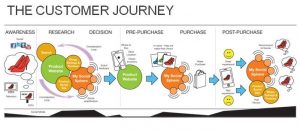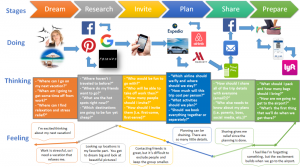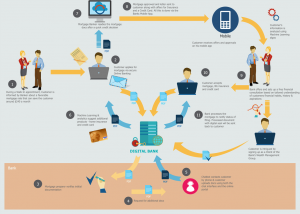Customer journey mapping – what is it?
“Try to see it my way,
Only time will tell if I am right or I am wrong.
While you see it your way
There’s a chance that we may fall apart before too long.”
Besides being very catchy (and probably sticking in your mind for the rest of the day) this song by the Beatles has some great points.
Wouldn’t it be awesome to be able to know the other person’s perspective in a relationship?
Like, really know it. Feel the way your partner feels. Understand his or her thoughts.
This could be useful in any relationship – in a friendly one, a romantic one, or a professional one.
We will leave the first two to the professionals with psychology degrees.
When it comes to understanding your customers, however, we have some ideas on how to learn to understand them a little better. Companies can use a process called customer journey mapping to understand customer experience – from beginning to end.
Don’t worry, the process is not as complicated as, say, figuring out what your girlfriend is thinking.
In the article, we will break it down for you.
It might even be catchy enough to stick with you like the Beatles song.
What is Customer Journey Mapping
A customer journey map is an illustration or diagram of all the touchpoints your customers have with your company, online or off.
The maps vary from customer to customer and from industry to industry.
Below are some examples of what a customer journey map might look like.
A purely visual one:

One with a bit more information:

One that contains both, vivid visuals and data point:

Marketing experts agree that understanding what the customers are doing and feeling is important to building successful customer experiences.

If we have a clear picture of what customers think, do, and feel throughout their entire experience with our company – before, during, and after the actual transaction – we can adjust and tailor what we do to make that experience more satisfying.
The customer journey mapping process is such an important part in planning for an amazing customer experience. Success doesn’t happen by accident. The journey map is part of creating deliberate success.
— Shep Hyken (@Hyken) July 3, 2018
Just knowing what your customers are doing and feeling is one thing. Seeing it in a visual form of an illustration – or map – is much more beneficial. Sharing the document with everyone on your team can also put everyone on the same page. Literally.
By understanding what [customers’] motivations are, you can understand how to structure your touchpoints to create the most effective and efficient process for your customers. A customer journey map maps out the current process, from the first to final touchpoint, to see if your customers are currently reaching the goals and, if not, how they can.
Customer journey maps help us connect with our clients better because we have a visual representation of what they are doing. We can connect with them on a more personal level. and understand their challenges and frustrations. We can recognize opportunities to create more positive experiences with our brand.
Steps to Creating a Map
So what are some steps to successful customer journey mapping?
If you ask five different marketing experts how to successfully create a customer journey map you will probably get five different answers.
Here is a quick guide we put together after reviewing tips and strategies of customer journey mapping from the top customer experience professionals.
Step 1. Plan
In this step, we select the persona whose experience we are tracking and whatever goal he or she may have.
It’s best to pick one persona, one scope, and one scenario. Doing so avoids a map that is too generic and too vague.
How to select the perfect person for your mapping? By asking the following questions:
The basics:
- age
- household income
- marital status
- location
- gender
Further questions to consider:
- How do they like to interact with vendors?
- How do they learn about products/services like yours?
- What are other items they have purchased in your niche?
- What do they engage with in relation to your competitors?
- Where are they most active when looking for solutions to problems?
- What content formats do they engage with?
Step 2. Identify touch points
Touchpoints are all the interactions your persona will have with your company. The good, the bad, and the ugly.
This is where you can review how and when customers interact with your company. You can identify the moments of truth, which are the times when certain interaction will determine if the customer will remain a loyal patron or if he or she will leave the business. Digital marketing attribution software can help you identify all the touchpoints.
You can find out what are some pain points a customer might encounter during the experience.
It’s also valuable to learn what your company is doing right. Tools such as online reviews and other client feedback channels can come useful during this stage.
Step 3. Empathize
This is where the good stuff is; this is where you walk a mile in your customer’s shoes.

You find out how your customers feel throughout their experience with your brand.
Some questions to ask during this step include what the customers are doing, seeing, hearing, and feeling.
Getting this information and supporting it with data, documents, photos, videos, responses, and other input from the customer service team as well as the customers themselves will give the customer journey mapping some substance.
You can use an empathy map template like the one below for this step.

This crucial part of the map will help determine the overall customer satisfaction with your company and brand.
Step 4. Brainstorm
This is where the customer journey mapping process will produce some outcomes.
As a team, you can brainstorm and see what comes up based on the information you’ve gathered so far.
Brainstorming during customer journey mapping is similar to any other brainstorming session. Members of your team will come up with ideas and then organize them in a relatable to your map.
Kate Kaplan, a UX specialist has great tips on how to organize and prioritize ideas.
Step 5. Create an affinity diagram
Now comes the visual part.
All the data you’ve collected, together with any brainstormed ideas that made the final cut you can put together a diagram that illustrates and brings together everything you’ve learned.
Some benefits of the affinity diagramming include:
- Understand what is most important from ambiguous data
- Tame complexity
- Identify connections in data
- Create hierarchies
- Identifying themes
- Identify what factors to focus on that will support the most successful design possible from a customer’s perspective.
There are many tools you can use for this step, from a whiteboard and sticky notes to more sophisticated software tools.
Select what works best for you and your team. Be creative.
This is the final visual result of your customer journey mapping process,
Step 6. Share and Implement
Now that you’ve completed the map it’s time to share it with everyone in your company. This will promote collaborative action on different levels – from sales to the customer service department to marketing.
If everyone has the same vision in mind it will be easier to achieve the goal you set up for your company.
And since sharing is caring we want to share a customer journey map template from our friends at Miro.
Conclusion
Understanding your customers’ experience with your brand is essential to your success.
Customer journey mapping puts you in your clients’ shoes and gives you a better understanding of that experience.
Once you complete the process it’s time to continue your work and implement change based on what you’ve learned.
So get to work!
And before you go, here is that Beatles song you’ve been singing in your head:
How does the customer journey mapping help you in your company?




